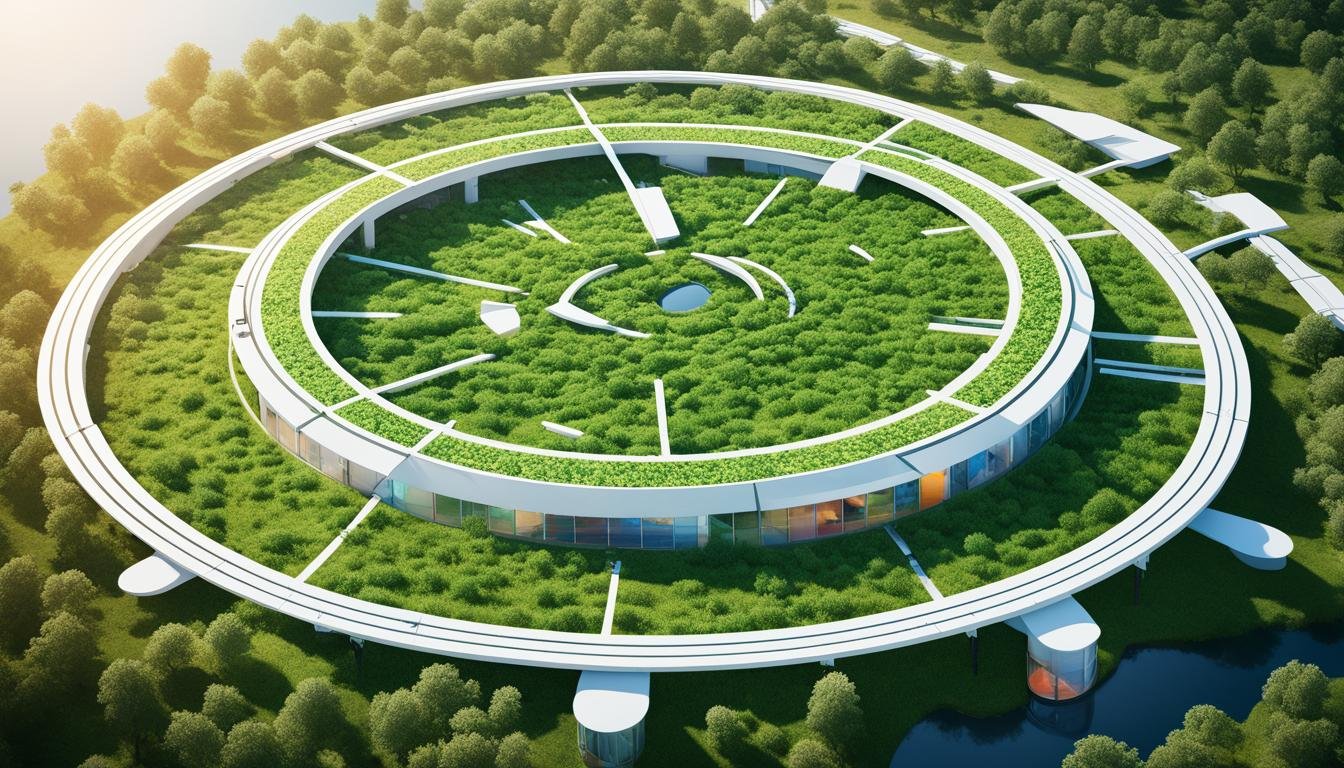Recently, the fashion world changed a lot, moving towards being more sustainable and ethical. People now consider the impact of their fashion choices on the world. This has led to a growing need for sustainable products. When we talk about sustainable fashion, it’s more than just what we wear. It’s about the complete life of an item.
This approach aims to reduce harm to the environment, ensure fair wages for workers, and use materials that are good for the earth. This change marks a big shift in how we view fashion’s impact on creating fairness and a better environment for all.
Key Takeaways:
- Consumers have become more aware of the social and environmental impacts of their fashion choices.
- Sustainable fashion goes beyond clothes to include the entire lifecycle of a garment.
- It aims to minimize the industry’s environmental footprint and promote fair labor standards.
- Eco-friendly materials are used to create sustainable fashion.
- The shift towards sustainability represents a reimagining of the fashion industry’s role in promoting a more just and sustainable world.
The Environmental Impact of Fashion
Fast fashion is on the rise, impacting our planet negatively. It heavily depends on harmful farming, high energy use, and toxic chemicals. These practices lead to deforestation, use up resources, and pollution.
This quick, disposable fashion has made us overbuy, throwing away clothes after few wears. The constant need for new and cheap clothes leads to environmental strains. It also encourages a culture of using and disposing of items quickly.
“Fast fashion has a devastating impact on our planet, from the excessive water usage in cotton farming to the toxic chemicals used in dyeing and finishing textiles.”
Thankfully, the industry is moving towards a more sustainable approach. They are now looking into organic farming for materials like cotton and hemp. This reduces water pollution and helps the soil stay healthy.
Brands are also finding ways to use less water during production. They’re rethinking their dyeing and fabric finishes and choosing to recycle water. This helps protect water sources and the environment.
In their efforts to be sustainable, fashion companies are turning to renewable energy. They use the power of the sun, wind, or water to operate. This cuts down on climate change and makes the fashion industry greener and more efficient.
People are becoming more conscious of their fashion’s impact on the environment. They are choosing clothes that are made ethically and sustainably. This has pushed brands to find new ways to design, focusing on eco-friendly methods. By using organic materials, saving water, and turning to clean energy, they’re making a difference for the planet.
Environmental Impact Comparison – Conventional vs. Sustainable Fashion
| Environmental Impact | Conventional Fashion | Sustainable Fashion |
|---|---|---|
| Resource Depletion | Excessive energy consumption, deforestation | Reduced energy usage, prioritizes conservation |
| Pollution | Toxic chemicals in dyes and finishes | Embraces eco-friendly alternatives |
| Water Usage | High water consumption in cotton farming | Water-saving techniques, minimizes water usage |
| Greenhouse Gas Emissions | Reliance on fossil fuels for energy | Transition to renewable energy sources |
| Waste Generation | Overproduction leads to garment disposal | Promotes circularity, reduces waste |
Embracing Circular Fashion
Sustainable fashion is moving towards circular practices. These practices reduce waste and use resources better. Circular fashion focuses on reusing, recycling, or biodegrading materials. This approach cuts down the fashion industry’s environmental harm. It paves the way for a sustainable future.
Clothing rental and resale are big in circular fashion. They let people wear many clothes without owning them. Buying second-hand or renting clothing lessens the need for new clothes. This reduces waste because it extends the life of garments.
Zero-waste design is also crucial. Designers work to make clothes with less material waste. They use smart patterns and leftover fabric. This creates new clothes or accessories from old scraps.

Recycling technologies are key. They turn old textiles into new fibers. This reduces the need for new, raw materials. It cuts down the fashion industry’s environmental harm a lot.
Embracing circular fashion is an environmental must and a chance for new ideas and growth. By using rental, zero-waste design, and recycling, the fashion world can become greener. It can make value from waste and head towards regenerating resources.
The Benefits of Circular Fashion
Moving towards circular fashion helps in many ways:
- It cuts down the fashion world’s waste and resource use.
- It makes clothes last longer, needing fewer new ones and saving nature’s resources.
- It promotes using rented or second-hand clothes.
- It sparks new, more earth-friendly ways to make clothes.
- It opens up new jobs in rental, resale, and recycling, growing the green fashion sector.
Circular Fashion Initiatives
| Initiative | Description |
|---|---|
| Clothing Rental and Resale Platforms | Online platforms that let you rent or buy second-hand clothes, pushing for garment reuse. |
| Zero-Waste Design Techniques | Design methods that avoid wasting fabric, like unique pattern cutting and using scrap textiles again. |
| Recycling Technologies | Innovative ways to turn old textile waste into new fibers or materials for new clothes or accessories. |
By turning to circular fashion, the fashion industry can change. It can lead to a greener, more efficient future.
Prioritizing Social Responsibility
Sustainable fashion is more than being eco-friendly. It’s about caring for people too. The clothing industry often mistreats its workers, especially in poor countries. But, ethical brands are changing this by focusing on fair pay, safe jobs, and clear production lines.
These ethical brands work with fair trade suppliers. This means the people making clothes get paid fairly. It gives them better lives and supports fighting poverty and injustice.
These brands also ensure that factories are safe. They check the working conditions often to make sure they’re not dangerous.
Being open about how clothes are made is key. Ethical brands share their story with customers. They tell about how they care for their workers, encouraging trust and a close relationship with shoppers.
“Sustainable fashion is not just about the clothes we wear; it’s about the people who make them. By prioritizing fair labor practices, we can create a fashion industry that respects and values every individual involved in the production process.”
Brands that focus on social responsibility are changing fashion for the better. They make sure choices are beautiful and good for people and the planet.
Successful Case Study: Patagonia
Patagonia leads in being social and eco-friendly. This brand is famous for treating its workers well and using safe conditions. It’s also clear about where its products come from. It works with Fair Trade Certified™ factories, ensuring fairness all the way.
Patagonia also asks its buyers to fix and reuse their clothes. This helps the earth and makes a big positive impact. Other brands look up to Patagonia for its high standards and great ideas.
Key Principles of Social Responsibility in Sustainable Fashion
| Principles | Explanation |
|---|---|
| Ethical Labor Practices | Prioritizing fair treatment, fair wages, and safe working conditions for all workers involved in the fashion supply chain. |
| Fair Trade Suppliers | Collaborating with certified fair trade suppliers who adhere to ethical labor standards and worker empowerment. |
| Transparency | Openly communicating labor practices, supply chain information, and brand values to consumers. |
| Worker Empowerment | Empowering workers by promoting fair wages, skill development, and a safe working environment. |
Conclusion
Sustainable fashion is much more than a fad; it’s a powerful force for change. It alters the fashion world by mixing ethics with beauty. Choosing sustainable options, we improve the industry and move towards a cleaner, fairer future.
Being a mindful shopper is crucial. We should pick brands that care about the earth and the people who make our clothes. Supporting strict rules for the fashion world will make it more responsible for its effects on society and the environment.
Working together, we can transform fashion into a positive influence. When we value the making of our clothes and what we buy, we make the fashion world better. Let’s focus on sustainability and ethical choices. This way, we shape a fashion business that respects everyone and our planet. It’s time to change the way we look at fashion and make it a friend to our world.
FAQ
What is sustainable fashion?
What are some examples of sustainable fashion choices?
How does sustainable fashion help the environment?
What is circular fashion?
How does sustainable fashion promote social responsibility?
Source Links
- http://www.montreal.tv/2023/07/sustainable-fashion-redefining-style-with-eco-friendly-choices/
- https://medium.com/@omisakinmonioluwa/sustainable-fashion-redefining-style-with-ethical-and-eco-friendly-practices-8f857f4d6ee4
- https://medium.com/@talentwriter/sustainable-fashion-redefining-style-with-eco-friendly-choices-589ad7257d7e


